
* After a working out early problems, the P-47 went into combat in Europe in 1943. Pilots took some time to assess it strengths and weaknesses, but it soon proved effective, both in long-range escort and close-support roles, and also saw action against the Japanese. The British RAF, as well as the Free French and Brazilians, flew the P-47 as well. Refined variants were introduced into production, and a number of experimental derivatives were built.
* By the end of 1942, most of the troubles with the P-47 had been worked out, the American war machine was coming on line, and P-47Cs were sent to England for combat operations. The 56th Fight Group was sent overseas to join the Eighth Air Force, whose 4th and 78th FGs were equipped with the Thunderbolt as well.
The 4th FG was built around a core of experienced American pilots who had served with the British Royal Air Force (RAF) before the US entry into the war in the famous "Eagle Squadron". They were not too pleased to trade their nimble Spitfires for the big Thunderbolt. Indeed, their British counterparts were astounded when they saw the huge fighter, since it hardly seemed such a big aircraft could get off the ground, much less engage in air combat. The British joked that a Thunderbolt pilot could defend himself from a Luftwaffe fighter by running around and hiding in the fuselage.
Few American pilots were neutral about the Thunderbolt; they either hated it or loved it. On the negative side, there was the unpleasantly long take-off run, and the P-47 was not particularly maneuverable, though it was surprisingly agile at high altitudes. One Thunderbolt pilot compared it to flying a bathtub around the sky. A dead-stick landing with the P-47 was likely a frightening exercise. On the positive side, it was rugged, heavily armored, and well armed. It was a stable gun platform and its eight 12.7-millimeter Brownings could pour out a heavy volume of lead; pilots reported targets unlucky enough to be caught in a P-47's crosshairs simply exploded or disintegrated.
The Thunderbolt could drop like a brick, which was an advantage in air battles. Luftwaffe pilots would find out that trying to break off combat and dive away was sheer suicide when fighting a Thunderbolt. The P-47 could easily reach 885 KPH (550 MPH) in a dive, and some Thunderbolt pilots claimed it could even break the sound barrier, but it just appears that the airspeed indicator simply went crazy at high speeds. One pilot said: "I have never seen a plane that could get rid of such appalling hunks of altitude in so short a time." At the outset it was sluggish in a climb, "like a brick" was common comment. One pilot commented: "By God, it ought to dive -- it certainly won't climb."
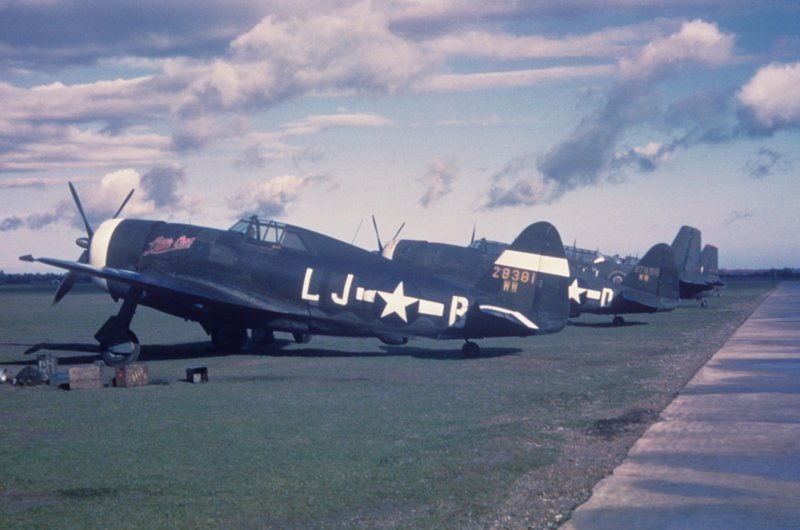
The P-47's first combat mission was on 10 March 1943, when the 4th FG took their aircraft on a fighter sweep over France, which turned out a fiasco due to radio malfunctions. The P-47s were all refitted with British radios, and missions resumed on 8 April 1943. The P-47 first mixed it up with the Luftwaffe on 15 April, with Major Don Blakeslee of the 4th FG scoring the Thunderbolt's first kill, shooting down an FW-190. On 17 August 1943, the P-47 performed its first escort mission, when it guarded a B-17 force on the first leg of a raid on Schweinfurt, Germany.
By the summer of 1943, the P-47 was also in service with the 12th Air Force in Italy. It was fighting against the Japanese in the Pacific as well, with the 348th FG flying escort missions out of Brisbane, Australia.
BACK_TO_TOP* Refinements of the Thunderbolt continued, leading to the definitive "P-47D". 12,602 P-47Ds were built, though the "D" model actually consisted of a series of subvariants, the last of which were visibly different from the first.
The first P-47Ds were actually the same as P-47C-2s. Republic could not produce Thunderbolts fast enough at its Farmingdale plant on Long Island, and so a new plant was built at Evansville, Indiana. The Evansville plant built a total of 110 P-47Ds, which were completely identical to P-47C-2s. By the way, Farmingdale aircraft were given a "-RE" suffix, while Evansville aircraft were given a "-RA" suffix -- but for clarity, this scheme is not used in this document except when necessary.
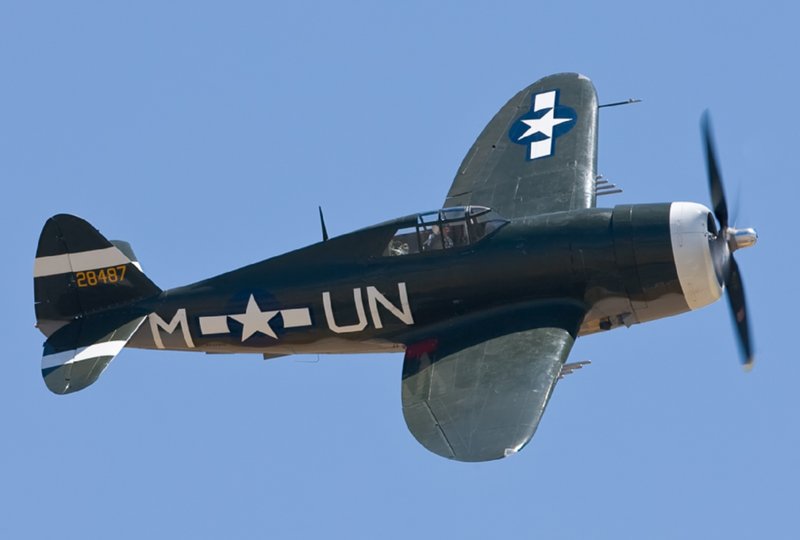
The P-47D was built in a very large number of subvariants. Some of the subvariants were manufactured only at Farmingdale, some were only manufactured at Evansville, some were manufactured at both plants. The changes in subvariants were often minor and a detailed description of them all would be tedious, but it is useful to point out the highlights. Note that there were breaks in the subvariant numbering sequence, and though the last of them was the P-47D-40, forty different subvariants were not produced.
The "P-47D-1" through "P-47D-6", the "P-47D-10", and the "P-47D-11" successively incorporated changes such as the addition of more engine cooling flaps around the back of the cowl, greatly reducing the engine overheating problems that had been seen in the field; engine water injection for combat power; refinements to fuel, oil, hydraulic systems; and additional armor protection for the pilot.
The "P-47D-15" was a big step forward, produced in response to requests by combat units for more range. The internal fuel capacity was increased to 1,402 liters (370 US gallons), and the wings were "plumbed" to allow a drop tank to be carried under each wing, in addition to the belly tank.
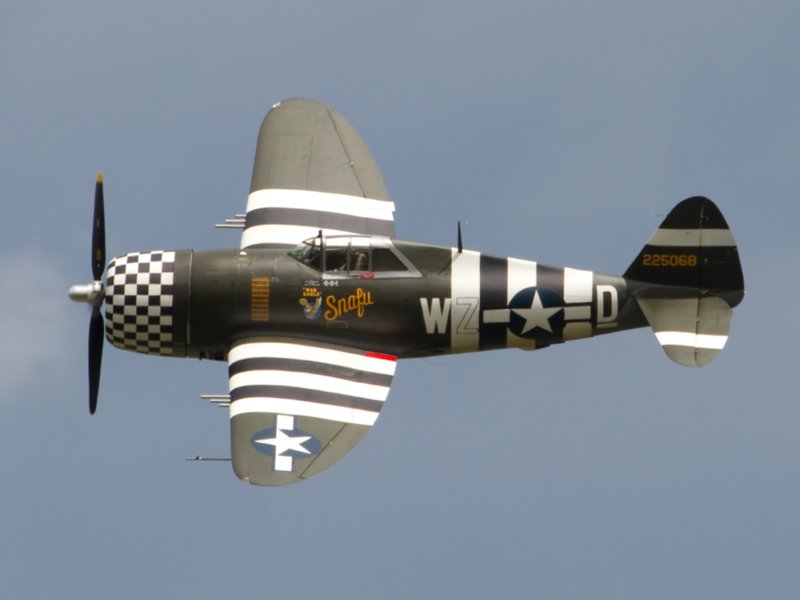
A variety of different drop tanks were fitted to the Thunderbolt during its career. Following the early conformal 758-liter (200 US gallon) ferry tank and the lozenge-shaped flat 758-liter belly tank, teardrop-shaped 284-liter (75 US gallon) and 568-liter (150 US gallon) metal wing drop tanks were adopted. The P-47 also used British-designed 409-liter (108 US gallon) and 758-liter tanks made of plastic-impregnated paper. These tanks were cheap and were useless to the enemy if found after being dropped, though they could not store fuel for an extended period of time. With the increased fuel capacity, the P-47 was now able to perform missions deep into enemy territory. The P-47D-15 could carry up to 1,130 kilograms (2,500 pounds) of external stores.
The "P-47D-16", "P-47D-20", "P-47D-22", and "P-47D-23" were similar to the P-47D-15, adding minor improvements in fuel system, engine subsystems, a jettisonable canopy, bulletproof windshield, and so on. The 3.71-meter (12 foot 2 inch) Curtiss propeller was replaced by new and bigger propellers, the Long Island plant moving to a Hamilton Standard propeller with a diameter of 4.01 meters (13 feet 1-7/8 inches), and the Evansville plant moving to a new Curtiss propeller with a diameter of 3.96 meters (13 feet). The new propeller further boosted the climb rate, and Luftwaffe pilots now found they couldn't get away from the P-47 by climbing.
Achieving ground clearance on take-off for the propeller had been troublesome in the XP-47B. With the bigger propeller, Thunderbolt pilots had to learn to be careful on take-offs to keep the tail down until they obtained adequate ground clearance; failure to do so caused the prop to divot the runway. However, the new propeller did reduce the take-off run.
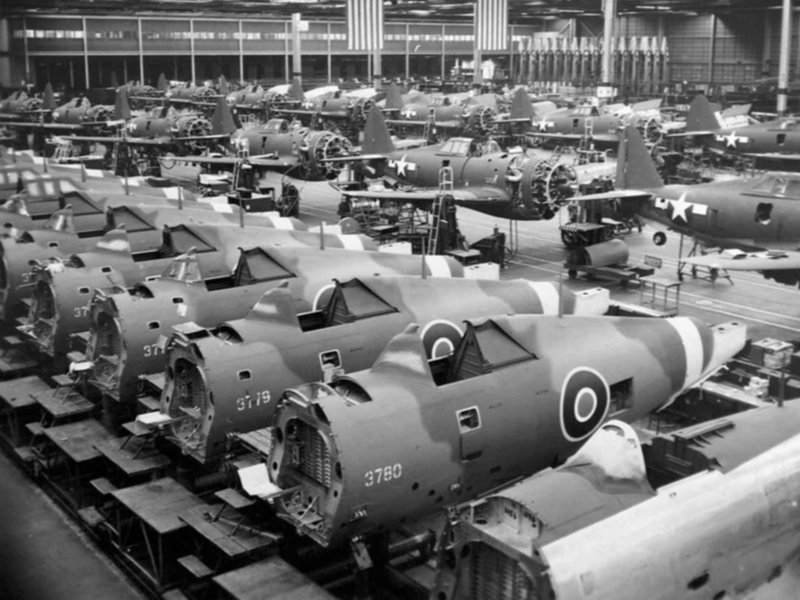
* Even with two Republic plants rolling out the P-47, the USAAF still wasn't getting as many Thunderbolts as the brass wanted, and so an arrangement was made with Curtiss to build the P-47 under license in a plant in Buffalo, New York. Most of the Curtiss Thunderbolts were intended for use in advanced flight training. The Curtiss aircraft were all designated "P-47G", and a "-CU" suffix was used to distinguish them from other production. The P-47Gs were all identical to various P-47C and P-47D blocks, with the block equivalents and production quantities broken down as follows:
That gave total P-47G production as 354 machines. Two of the Curtiss-built P-47G-15s had the cockpit extended forward to just before the leading edge of the wing to provide twin tandem seating, and designated "TP-47G". The second crew position was accommodated by substituting a much smaller main fuel tank. The "Doublebolt" didn't go into production, but two-seat modifications were made in the field to older P-47s, which were then used as hacks. The cockpit was not moved forward on these improvised Doublebolts.
* All the P-47s produced to this time had the razorback canopy configuration, which was a source of complaints since it left pilots with no field of view in the vital "6:00" position to the rear. The British also had this problem with their fighter aircraft, and had devised the bulged "Malcolm hood" canopy for the Spitfire as an initial solution. This was field-fitted to many North American P-51 Mustangs and, it seems, to a handful of P-47Ds.
However, the British then came up with a much better solution, devising an all-round vision "bubble" canopy for the Hawker Tempest. USAAF officials liked the bubble canopy and quickly adapted it to American fighters, including the P-51 and the Thunderbolt. The initial P-47 with a bubble canopy was completed in the summer of 1943, being modified from the last production P-47D-5 and designated "XP-47K". Another older P-47D had been modified to provide an internal fuel capacity of 1,402 liters (370 US gallons) and given the designation "XP-47L". The bubble top and increased fuel capacity were then rolled into production together, resulting in the "P-47D-25". Pilots regarded the new canopy as a vast improvement.
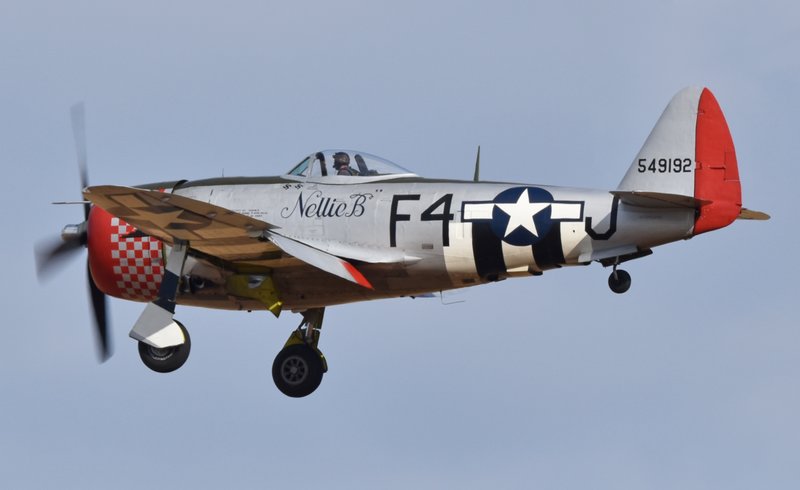
It was followed by similar bubble-top variants, including the "P-47D-26", "P-47D-27", "P-47D-28", and "P-47D-30". Improvements added in this series included engine refinements, more internal fuel capacity, the addition of dive flaps to help recovery from dives, and other tweaky changes.
___________________________________________________________________
REPUBLIC P-47D-25-RE:
___________________________________________________________________
wingspan:
12.4 meters (40 feet 9 inches)
wing area:
27.87 sq_meters (300 sq_feet)
length:
11.0 meters (36 feet 1 inch)
height:
4.3 meters (14 feet 2 inches)
empty weight:
4,850 kilograms (14,600 pounds)
max loaded weight:
8,800 kilograms (19,400 pounds)
maximum speed (at 9,000 meters / 30,000 feet):
690 KPH (428 MPH / 372 KT)
service ceiling:
12,000 meters (40,000 feet)
range (with three drop tanks):
3,060 kilometers (1,900 MI / 1,725 NMI)
___________________________________________________________________
The "P-47D-40" was the final P-47D subvariant, and was a more significant update. Cutting down the rear fuselage to accommodate the bubble canopy had led to yaw instability in the aircraft's flight, so the P-47D-40 had a neat dorsal fin extension in the form of a narrow triangle running from the tailfin to the radio aerial. The fin extension was retrofitted in the field to earlier P-47D bubble-top variants.
The P-47D-40 also featured provisions for ten "zero length" stub launchers for 12.7 centimeter (5 inch) "High Velocity Air Rockets (HVARs)", and was also fitted with the new "K-14" computing gunsight. The K-14 was a license-built copy of the British Ferranti GGS Mark IID computing gyro sight, which allowed a pilot to dial in target wingspan and range, and would then tell the pilot when he had a good shot at the target. The K-14 was a great assistance in deflection shooting, earning the nickname of "ace-maker" -- though pilots who were "naturals" at deflection shooting tended to find it a complicated bother.
BACK_TO_TOP* The P-47D, as the first really satisfactory version of the Thunderbolt and the most heavily produced variant by far, bore the brunt of the P-47's combat service.
By 1944, the Thunderbolt was in combat with the USAAF in all its operational theatres, except Alaska. With increases in fuel capacity as the type was refined, the range of escort missions over Europe steadily increased until the P-47 was able to accompany bombers in raids all the way into Germany itself. On the way back from raids, pilots shot up targets of opportunity, which led to the realization that the P-47 made an excellent fighter-bomber. Even with its complicated turbocharger system, it could absorb a lot of damage, and its eight machine guns meant it could cause a lot of damage as well.
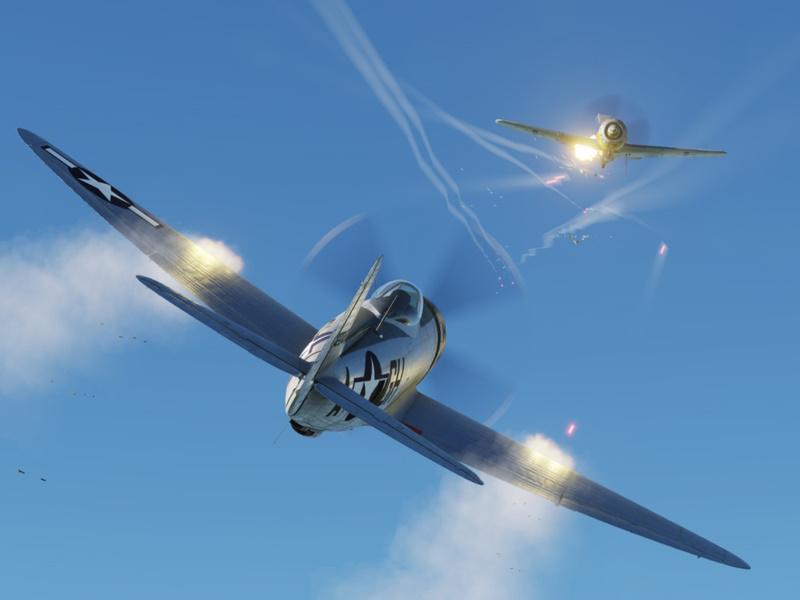
Gradually, the P-47 became the USAAF's best fighter-bomber, carrying 225-kilogram (500-pound) bombs, sometimes with extended "daisy cutter" fuzes to provide greater blast effect against exposed targets; napalm tanks; the triple-tube M-8 11.5-centimeter (4.5-inch) rocket launcher -- which was inaccurate and was eventually replaced by the much better HVAR. Thunderbolts were one of the mainstays of the USAAF in tactical support of the Normandy landings, and continued the tradition through the rest of the war, destroying thousands of tanks, locomotives, and parked aircraft, and tens of thousands of trucks and other vehicles.
The P-51 Mustang gradually replaced the Thunderbolt in the long-range escort role, since the Mustang had superior range and a more comfortable cockpit. However, the P-47 still ended the war in Europe with impressive scores in air combat. Lieutenant Colonel Francis S. "Gabby" Gabreski scored 31 kills, Captain Robert S. "Bob" Johnson scored 28, and Colonel H. "Pop" Zemke scored 20. It is a tribute to the aircraft's ruggedness that all ten of the top-scoring Thunderbolt aces survived the war.
Some Thunderbolts were modified to a "Superbolt" configuration to improve their performance in air combat. The Superbolts had half their guns and some armor removed, featured engine modifications to allow them to burn higher-octane fuel, and featured a highly polished finish.
A number of war-weary P-47s were actually used in the air-sea rescue (ASR) role, carrying a rubber life raft in a pack under each wing and carrying flares under the rear fuselage to mark the position of downed aircrew. They went into service in this role in the spring of 1944. The ASR Thunderbolts retained most or all of their gun armament, and one shot down a German V-1 flying bomb.
* The Thunderbolt also provided extensive service against the Japanese, by both the USAAF and the British. The RAF began to receive the type during mid-1944, receiving 240 razorback P-47Ds, which they designated "Thunderbolt Mark I", and 590 bubble-top P-47Ds, which they designated "Thunderbolt Mark II".
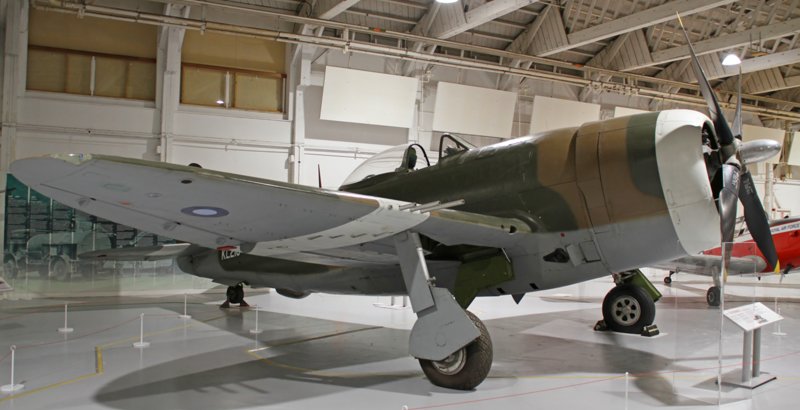
Except for a few evaluation aircraft, these were all operated by the RAF from India for ground-attack operations, known as "cab rank" sorties, against the Japanese in Burma. They were armed with 225-kilogram (500-pound) bombs, or in some cases the British "60-pounder" rocket projectiles. Since the Thunderbolt resembled the smaller Japanese Nakajima Ki-44-II Shoji ("Tojo") fighter, RAF Thunderbolts were often painted with white "recognition bands", and recognition markings were also adopted by USAAF Thunderbolts operating in the theatre. The Thunderbolts remained in RAF service for a short time after the war, the last of them being phased out of service in October 1946.
The Brazilian Air Force received 88 P-47Ds and flew them in combat during the Italian campaign. Mexico received 25 for operations against Japan and flew a squadron in combat over the Pacific under USAAF command. The Free French received 446 P-47Ds beginning in March 1944, with these machines supporting the drive through southern France and into Germany. French Thunderbolts would see action in the 1950s during the insurrection in Algeria.
203 P-47Ds were also provided to the Soviet Union, with certain irony in sending aircraft designed by a Russian emigre back to Russia. The Soviets were unimpressed with the P-47, one test pilot saying it "did not make a fighter." It could not match the agility of the lighter Soviet fighters, while it could not compete with the heavily armored purpose-designed Il-2 Shturmovik in the close-support role. The notion of a long-range, high-altitude escort fighter was somewhat foreign to Red Air Force doctrine, and the P-47 just didn't fit in.
The Luftwaffe operated at least three captured P-47s. They were used for comparative evaluation, in propaganda films, and may have been used on reconnaissance missions over the UK. German fighter ace Adolf Galland checked out a P-47 and found the cockpit so roomy that he felt "he could walk around in it."
BACK_TO_TOP* Although the P-47D was the high point of the Thunderbolt's career in terms of quantity and use, there were further attempts to refine the type.
Two "XP-47Hs" were built. They were major reworkings of existing razorback P-47Ds to accommodate a Chrysler XI-2220-11 water-cooled inline 16-cylinder inverted vee engine. Really big inline aircraft engines didn't prove to be a good idea in general -- diminishing returns had set in -- and the XP-47H went nowhere.
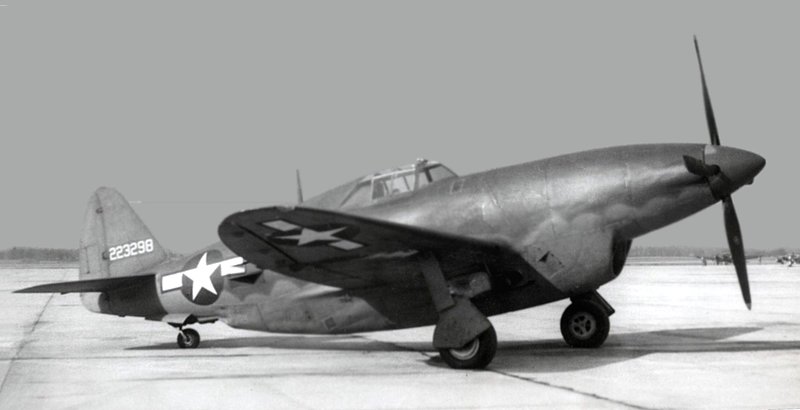
The "XP-47J" began as a November 1942 request to Republic for a "hot rod" version of the Thunderbolt, using a lighter airframe and an uprated engine with water injection and fan cooling. Kartveli designed an aircraft fitted a tight-cowled Pratt & Whitney R-2800-57(C) engine with a war emergency rating of 2,090 kW (2,800 HP), reduced armament of six machine guns, a new and lighter wing, and many other changes.
The first and only XP-47J was first flown in late November 1943, but by this time Republic had moved on to a new concept, the "XP-72", described below, and the XP-47J was used mainly as a trials machine. With various refinements, such as a GE CH-5 turbocharger, this aircraft achieved a top speed of 813 KPH (505 MPH) in level flight in August 1944, making it one of the fastest piston engine fighters ever built. However, the new jet aircraft being designed were clearly capable of much better performance, and the XP-47J was a dead end.
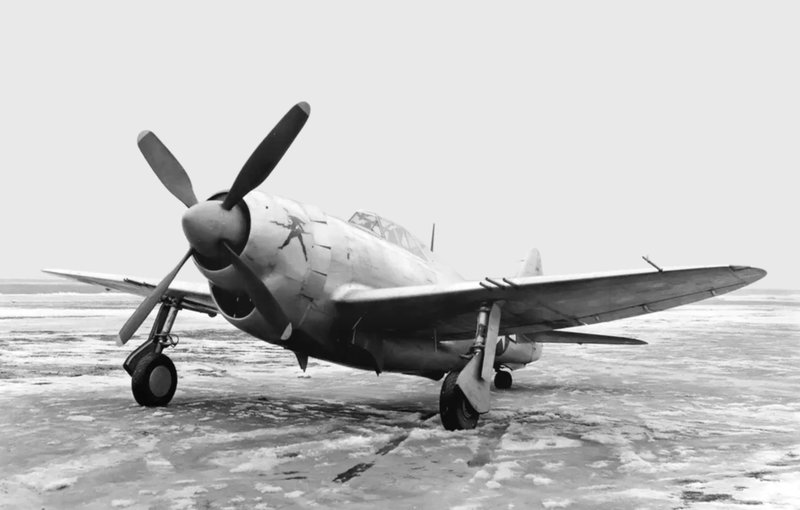
* The "P-47M" was a more conservative attempt to come up with a "hot rod" version of the Thunderbolt. Three "YP-47Ms" were built, consisting essentially of a late-model P-47D fitted with the P&W R-2800-57(C) engine and the GE CH-5 turbocharger. The performance of the YP-47M was excellent, with a top speed of 761 KPH (473 MPH), and the variant was rushed into production to counter the threat of the new German V-1 cruise missiles and German jet fighters. 130 P-47Ms were built, with the first arriving in Europe in early 1945. However, the type suffered persistent teething problems in the field, and did not see much action until the war was all but over.
* The "P-47N" was the last Thunderbolt variant to go into production, being intended for operations in the Pacific theatre. A fighter was needed to escort Boeing B-29 Superfortress bombers in raids on the Japanese home islands, flown over long stretches of the Pacific. Increased internal fuel capacity and drop tanks had done much to extend the Thunderbolt's range during its evolution, but the only way to cram more fuel into the aircraft was to put fuel tanks into the wings. That required a completely new wing, with each wing accommodating two fuel tanks, providing a total internal fuel load of 2,107 liters (556 US gallons) -- a 50% increase from late-production P-47Ds.
The second YP-47N was fitted with the new wing and flew in September 1944. The redesign proved successful in extending range to about 3,200 kilometers (2,000 miles), and the fact that the new wing, though longer than the old, had squared-off instead of elliptical wingtips improved the aircraft's roll rate.
The P-47N entered mass production with the uprated P&W R-2800-77(C) engine, beginning with the "P-47N-1", then the "P-47N-5", the "P-47N-15", the "P-47N-20", and the "P-47N-25", with a variety of small changes, such as a distinctive raised dorsal fin extension.
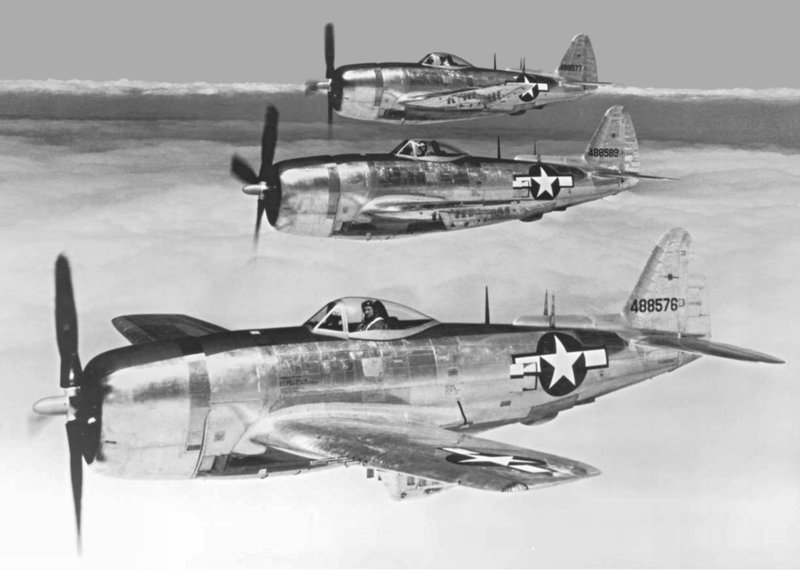
A total of 1,816 P-47Ns was produced. The very last Thunderbolt to be built, a P-47N-25, rolled off the production line in October 1945. Thousands more had been on order, but production was essentially cut off with the end of the war in August. At the end of production, cost of a Thunderbolt was $83,000 USD in 1945 dollars.
Although the P-47N had been designed for the Pacific theatre, early production of the variant was sent to England, though the war ended before they could see much action. P-47Ns arrived on Saipan in the spring of 1945 and conducted their intended escort missions, though they were more generally used in the fighter-bomber role.
BACK_TO_TOP* One of the interesting dead-end derivatives of the P-47 was the "XP-72", which was designed as a "Super Thunderbolt" that pushed the top limits of piston fighter development. It was powered by the 28-cylinder Pratt & Whitney Wasp Major air-cooled four-row 28-cylinder radial engine, providing 2,575 kW (3,450 HP) at altitude.
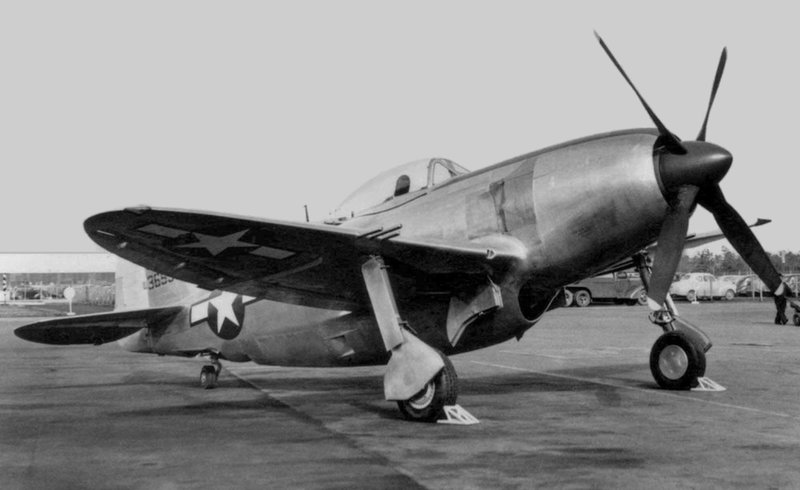
The XP-72 looked like a Thunderbolt, except for the fuselage ahead of the cockpit. The big Wasp Major engine was fitted in a tight cowl and capped with a big prop spinner, with the airscoop moved back to just under the leading edge of the wings. The XP-72 was armed with six 12.7-millimeter Brownings, and could carry a 450-kilogram (1,000-pound) bomb under each wing.
___________________________________________________________________
REPUBLIC XP-72:
___________________________________________________________________
wingspan:
12.5 meters (40 feet 11 inches)
wing area:
27.87 sq_meters (300 sq_feet)
length:
11.2 meters (36 feet 7 inches)
height:
4.42 meters (14 feet 6 inches)
empty weight:
4,970 kilograms (10,965 pounds)
loaded weight:
6,690 kilograms (14,750 pounds)
max speed at altitude:
790 KPH (490 MPH / 425 KT)
service ceiling:
12,800 meters (42,000 feet)
range:
1,930 kilometers (1,200 MI / 1,045 NMI)
___________________________________________________________________
The USAAF signed a contract for two XP-72 prototypes in June 1943, and the initial prototype flew on 2 February 1944. The first prototype had a big four-blade propeller. The second prototype first flew in July 1944, and was generally similar but used a contra-rotating six-blade propeller to deal with the brutal torque.
The second prototype was lost early in its flight test program, but the XP-72 was a very impressive aircraft, with excellent performance and a tremendous rate of climb. In fact, the USAAF ordered 100 production P-72s, apparently to be armed with four 37-millimeter cannon -- but even as the XP-72 was proving its merits, it was becoming obvious that jets were the way of the future. The contract was canceled, and the first prototype was scrapped at the end of the war.
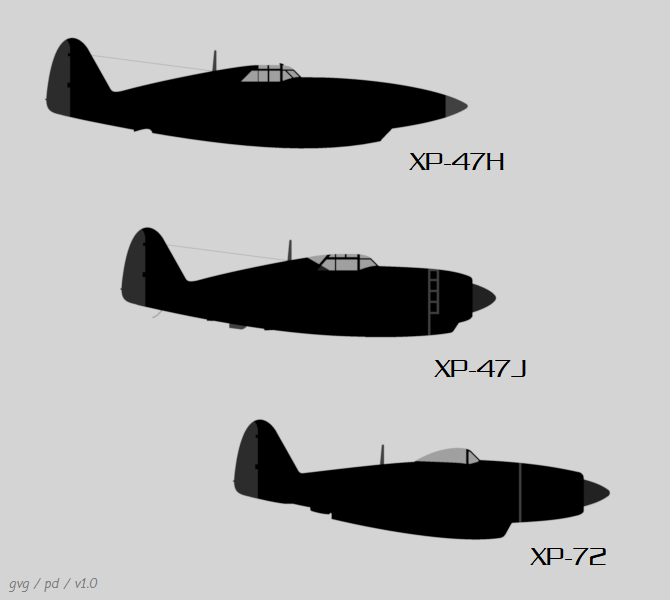
* The P-47 soldiered on after the war, serving with USAF (the Army Air Forces became the Air Force in 1947) until 1949, and then with the US Air National Guard until 1953, with the designation "F-47" from 1948. The P-47 didn't fight in the Korean War, apparently because the necessary quantities were no longer available: the F-51 Mustang was sent into the conflict to perform close-support instead, proving unpleasantly vulnerable to ground fire. The F-47 was provided to many Latin American air arms and was operated by them through the 1950s, and some used it well into the 1960s. Small numbers of Thunderbolts were also provided to China, Iran, Turkey, and Yugoslavia.
A total of 15,680 Thunderbolts of all types was built, making it one of the most heavily produced fighter aircraft in history. A number of P-47s have survived to the present day, and a handful are still flying. The following list gives Thunderbolt variants and production:
That gave total production of 15,680 Thunderbolts.
BACK_TO_TOP* As a footnote to the Thunderbolt story, the P-47 the only aircraft Republic produced during World War II -- but the company did start work on a four-engine long-range reconnaissance aircraft, the "F-12 Rainbow" -- "F" for "foto-reconnaissance" -- during the conflict. The Rainbow began life as a 1943 USAAF requirement for a reconnaissance aircraft capable of overflying Japan, with the aircraft to be able to fly "on all fours", meaning:
The first of two "XF-12" prototypes performed its initial flight on 4 February 1946, with Lowery Brabham at the controls, and handily exceeded requirements. The second followed on 12 August 1946, this machine being generally kitted up to operational spec.
The Rainbow was a sleek aircraft, with a cigar-shaped fuselage; straight, narrow-aspect, mid-mounted wings; wings; a straight tailplane and a tailfin with a guitar-pick profile, featuring a dorsal fillet and a ventral extension, it seems as a bumper. The top plexiglas panels of the glazed nose actually retracted for landings, to give the pilot and copilot a view through an optically-flat windscreen.
The nose gear had twin wheels and retracted backward, while the main gear had single wheels, and hinged from the inboard wing in towards the fuselage. it was powered by four Pratt & Whitney R-43600-31 Wasp Major 28-cylinder four-row air-cooled radial piston engines with 2,420 kW (3,250 HP) each, driving four-bladed fully-reversible Curtiss electric props -- the plan was originally to use contraprops, but they didn't work out. Each engine had dual turbochargers and featured water-methanol injection for boost power. Engine intakes were slots in the front of the wings, over a quarter of the span.
___________________________________________________________________
REPUBLIC XF-12 RAINBOW:
___________________________________________________________________
wingspan:
39.36 meters (129 feet 2 inches)
wing area:
152 sq_meters (1,640 sq_feet)
length:
28.59 meters (93 feet 10 inches)
height:
8.63 meters (28 feet 4 inches)
empty weight:
29,485 kilograms (65,000 pounds)
operating weight:
45,995 kilograms (101,400 pounds)
maximum speed (at operating altitude):
760 KPH (470 MPH / 410 KT)
cruise speed:
640 KPH (400 MPH / 350 KT)
service ceiling:
13,000 meters (44,000 feet)
range:
4,500 kilometers (4,500 MI / 3,900 NMI)
___________________________________________________________________
The XF-12 had three camera bays aft of the wings, containing:
For night photography, 18 photoflash bombs were carried in a small stores bay. `The bomb bay doors retracted flush to minimize drag. The XF-12 even included a darkroom to develop the film before landing. The first prototype was not fitted with reconnaissance kit. The first prototype was damaged on 10 July 1947 during landing tests; it was badly damaged, but returned to flight -- being redesignated "XR-12", the newly-minted US Air Force preferring "R" for "reconnaissance" instead of "F" for foto.
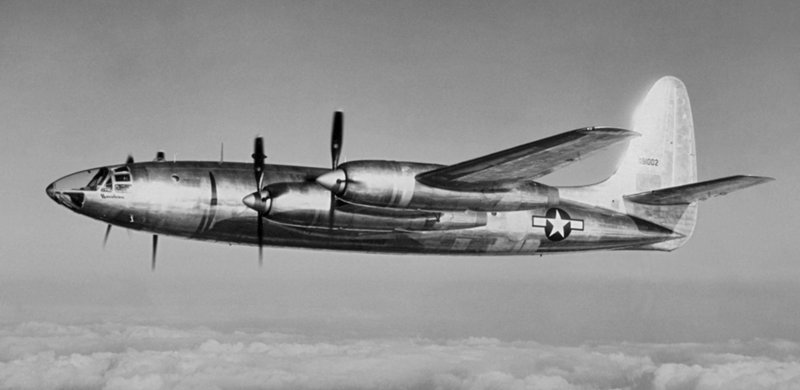
The second prototype performed a cross-country flight under Operation BIRDS EYE on 1 September 1948, flying at 12,000 meters from the Pacific Coast to Long Island, New York, taking images along the flight track. The trip took just under seven hours, average speed being 580 KPH (360 MPH).
On 7 November 1948, the second prototype crashed and was a loss, two of the five crew being killed. That was the effective end of the program. The end of the war meant there was no specific need for the Rainbow any more. The Boeing RB-29 Superfortress, the improved RB-50 Superfortress, and the Convair RB-36 could do the job until the advanced jet-powered Boeing RB-47 Stratojet entered service. The first prototype was retired in 1952, and came to an inglorious end as a ground gunnery target.
Republic had considered an airliner version of the Rainbow, the "RC-2", with an airliner fuselage carrying seven crew and 46 passengers and Wasp Majors with single turbochargers. There was some interest from the airlines, but it ended up being uncompetitive with rivals such as the Douglas DC-6 and Lockheed Constellation, and it didn't happen.
BACK_TO_TOP* Along with the XF-12, Republican also began work on a jet fighter during World War II, which would emerge after the conflict as the "F-84 Thunderjet". However, that is another story, discussed elsewhere.
One of the fun and tricky things about this write-up was trying to figure out the complicated engine and turbocharger layout of the Thunderbolt. I had a verbal description, but I had to read it a sentence at a time and then consult a cutaway diagram of the aircraft so I could see just what exactly was going on.
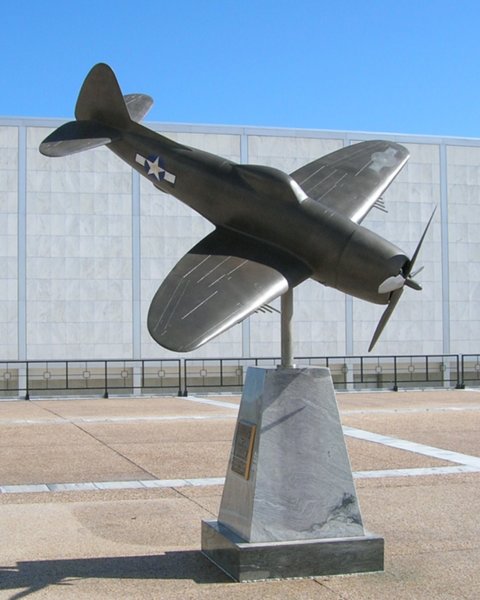
* Sources:
* Illustration credits:
* Revision history:
v1.0 / 01 jan 00 v1.1 / 01 may 01 / Review & polish. v1.2.0 / 01 jun 03 / Review & polish. v1.2.1 / 01 jun 05 / Review & polish. v1.2.2 / 01 may 07 / Review & polish. v1.2.3 / 01 apr 09 / Review & polish. v1.2.4 / 01 mar 11 / Review & polish. v1.2.5 / 01 feb 13 / Review & polish. v1.2.6 / 01 jan 15 / Review & polish. v1.2.7 / 01 dec 16 / Review & polish. v1.2.8 / 01 nov 18 / Review & polish. v1.2.9 / 01 sep 20 / Review & polish. v1.3.0 / 01 mar 23 / Went to 2 chapters, added XF-12.BACK_TO_TOP
